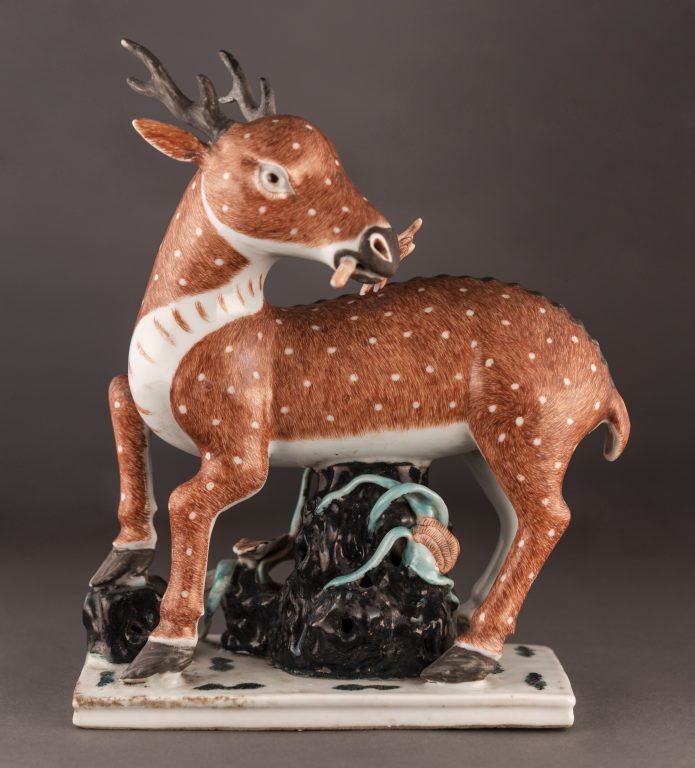Beauty in the Beasts A deer figure on display in a new Watson Galleries exhibit, "Auspicious Animals," is an example of the Chinese practice of blending European tastes with encoded symbolic meaning.
Decorative figures of animals were some of the most exclusive and expensive pieces of porcelain exported from China to Europe in the 1700s and 1800s. Wealthy Europeans decorated their homes with these figures and prized them for their beauty and elaborate designs. But these beasts boast more than just beauty; they reflect an established tradition in Chinese decorative arts of imbuing objects and images with symbolic as well as aesthetic value.
Sometimes this symbolic meaning can be drawn straight from legend or tradition, while other times it depends upon wordplay within the Chinese language. Homophones are a common source of symbolic meaning because there are many words in Chinese that are pronounced exactly the same. For example, the word for deer (lù 鹿) has the exact same phonetic pronunciation and tone mark as the word for a government official’s salary in pre-modern China (lù 禄), which is why deer are sometimes associated with monetary blessings and promotions.
This figure of a deer made in the early 19th century exemplifies how Chinese potters blended elaborate design for European tastes with encoded symbolic meaning, but it expresses a different wish unrelated to promotions or salaries. The deer stands with its head turned over one shoulder and holds in its mouth a spray of orange fungus. Its spotted body and front hoof rest on black stones full of holes that are covered in more fungus and long, drooping green leaves. The rectangular base also features small green plant-like motifs. While these may at first glance seem to be simple additions to create a more naturalistic and elaborate scene to entice European buyers, each of these design elements combine with the deer to create an auspicious wish for a long and happy life.
Valued as a food source and admired for their agility and grace, deer feature in some of the earliest examples of Chinese art and material culture, and have been associated with good fortune since the Han dynasty (206 BCE-220 CE). As various religions and philosophies developed in China, deer began to take on more specific auspicious associations. For example, the spotted deer became revered by Daoists as an animal with an incredibly long life span, which was attributed to the creature’s ability to locate the immortal fungus, known in Chinese as língzhī (灵芝). As a result, deer are often depicted enjoying their favorite fungus on many decorative objects of Chinese origin.
In addition to língzhī, many of the elements featured on this figure are also associated with longevity. While the stone supporting the deer was a necessary addition to prevent the clay body from collapsing in the kiln, it also supports the auspicious message of the figure itself. Oddly shaped stones full of holes were collected and classified by China’s educated elite as early as the Tang dynasty (618-906 CE), and this one can be identified as a longevity stone (shòushí 寿石) because of the plant life sprouting from crevices in the rock. More língzhī caps peek out from the stone, and the long green leaves are likely those of the narcissus, a flowering plant associated with longevity and immortality.
Another plant that often appears with deer in Chinese art, the pine, is also a symbol for longevity. Because of their hardiness and evergreen nature, pine trees have long been associated with longevity in Chinese tradition. Since modeling the thin, twisting branches of a pine would have been difficult and impractical for the potter designing this piece, pine boughs were instead painted onto the base. Not only does this solve the issue of how to include a pine tree in the figure, but it also creates the sense that the deer may be standing beneath a pine, another common scene in Chinese art and ceramics.
Though this deer’s original European owner likely purchased the figure for its opulence over its auspiciousness, the symbolic meaning remains, and it gives us an exceptional opportunity to see the kinds of artistic and cultural interactions between China and Europe during the China Trade.
This deer is on display in “Auspicious Animals: Chinese Export Porcelain Figures,” on view in the Watson Galleries until December 6, 2021. The deer, dogs, ducks and other animal figures are a promised gift to the Reeves Museum of Ceramics and were generously loaned to us for the exhibit by Mrs. Rogan. The exhibit was also made possible by the support of Steve and Mary Lynn Marks, and it was curated by Amelia Lancaster ’22, as part of a summer internship at the Reeves, and by Ron Fuchs II, senior curator of ceramics.
 This figure of a deer made in the early 19th century exemplifies how Chinese potters blended elaborate design for European tastes with encoded symbolic meaning.
This figure of a deer made in the early 19th century exemplifies how Chinese potters blended elaborate design for European tastes with encoded symbolic meaning.
You must be logged in to post a comment.